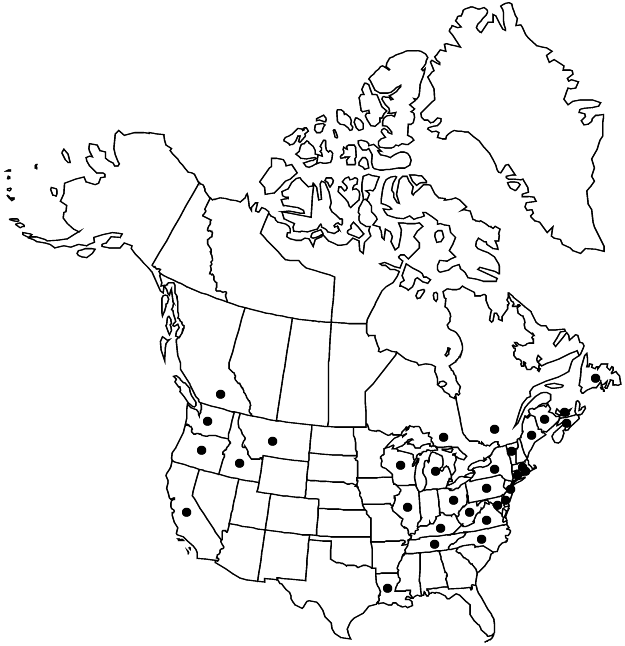Fallopia sachalinensis
Bot. J. Linn. Soc. 98: 369. 1988.
Herbs, perennial, rhizomatous, 2–4(–5) m. Stems usually clustered, erect, sparingly branched, herbaceous, stiff, glabrous, glaucous. Leaves: ocrea persistent or deciduous, brownish, cylindric, 6–12 mm, margins oblique, face without reflexed and slender bristles at base, otherwise glabrous or puberulent; petiole 1–4 cm, glabrous; blade ovate-oblong, 15–30(–40) × 7–25 cm, base cordate, margins entire, glabrous or scabrous to ciliate, apex obtuse to acute, abaxial face minutely dotted, glaucous, with hairs along veins distinctly multicellular, 0.2–0.6 mm, tips acute to acuminate, adaxial face glabrous. Inflorescences axillary, mostly distal, erect or spreading, paniclelike, 3–8 cm, axes puberulent to pubescent; peduncle 0.1–4 cm or absent, puberulent to reddish-pubescent. Pedicels ascending or spreading, articulated proximal to middle, 2–4 mm, glabrous. Flowers bisexual or pistillate, 4–7 per ocreate fascicle; perianth accrescent in fruit, greenish, 4.5–6.5 mm including stipelike base, glabrous; tepals obovate to elliptic, apex obtuse to acute, outer 3 winged; stamens 6–8; filaments flattened proximally, glabrous; styles connate basally; stigmas fimbriate. Achenes included, brown, 2.8–4.5 × 1.1–1.8 mm, shiny, smooth; fruiting perianth glabrous, wings flat to undulate, 1.8–2.2 mm wide at maturity, decurrent on stipelike base to articulation, margins entire. 2n = 44, 66, 102, 132 (Japan, Korea).
Phenology: Flowering Jul–Oct.
Habitat: Disturbed places
Elevation: 0-500 m
Distribution

Introduced; B.C., N.B., Nfld. and Labr. (Nfld.), N.S., Ont., P.E.I., Que., Calif., Conn., Del., Idaho, Ill., Ky., La., Maine, Md., Mass., Mich., Mont., N.J., N.Y., N.C., Ohio, Oreg., Pa., R.I., Tenn., Vt., Va., Wash., W.Va., Wis., Asia (Japan), introduced in Europe.
Discussion
Fallopia sachalinensis was introduced as a soil binder and garden ornamental. Like F. japonica, it spreads aggressively and has been declared noxious in California, Oregon, and Washington. It hybridizes with F. japonica, yielding F. ×bohemica. The mid-stem inflorescences of F. sachalinensis usually are shorter than the subtending leaves.
Selected References
None.